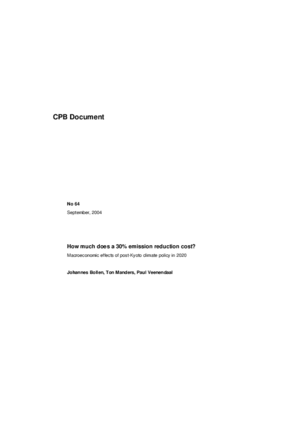How much does a 30% emission reduction cost? Macroeconomic effects of post-Kyoto climate policy in 2020
Costs of climate policy are smaller if developing countries join emissions trade
Having all countries join in to abate global warming will bring the estimated costs for the Netherlands to 0.8% of the Real National Income, measured against the background of a high economic growth scenario. However, if the group of countries engaged in climate policy remains confined to the industrialised countries, cheap options will vanish and costs will rise to 4.8% of the National Income.
This is the main conclusion drawn by CPB Netherlands Bureau for Economic Policy Analysis and MNP, the Netherlands Environmental Assessment Agency, in their joint study, How much does a 30% emission reduction cost?, the English version of which is coming out today. In this joint effort, Johannes Bollen (MNP), Ton Manders (CPB/MNP) and Paul Veenendaal (CPB) explore the macro-economic impacts of climate policies in the post-Kyoto era, providing answers to motion 29 200 XI, no. 40, made by De Krom and Spies, two members of the Dutch Parliament.
The industrialised countries are assumed to be pursuing emission reduction levels of 30% below their 1990 emissions. This regime conforms to the goal of the European Union in which the average world temperature should not increase by more than 2 degrees Celsius above the pre-industrial level. Given this global climate target and the aim of 30% reduction for industrialised countries, developing countries are allocated an emissions ceiling almost equal to their emissions in the background scenario in the absence of a climate policy. Such an allocation is compatible with a distribution on the basis of equal emission rights per head of the population.
The costs of climate policy can be highly variable, depending on the reduction ceiling, the underlying scenario of economic development and policy design. Given the 30% reduction target, large uncertainties surround the other two elements mentioned. A number of alternatives have been analysed to explore these uncertainties. The macro-economic consequences in 2020 have been assessed for each of these uncertainties against the background of two scenarios for economic development: 'Global Economy' with a relatively high economic growth and 'Strong Europe' with a more moderate growth. Climate policies are not assumed to have been taken up in either of these two background scenarios.
Costs can be kept relatively low when a system of tradable emission rights is in place, which will allow full use of cheap reduction options in participating countries. If emissions trading is efficient and all countries join up, the National Income in the Netherlands will, for the 'Global Economy' scenario, be reduced by 0.8% in 2020. If economic growth is lower, the effort needed to meet a given target will also be less. When placed against the background of a scenario with more moderate growth, the costs of global climate policy to the Dutch will amount to 0.2% of the National Income. Reduction in the group of countries participating may cause the costs to rise sharply. In 'Global Economy', for example, the costs for the Netherlands will increase to 4.8% of the National Income if only industrialised countries participate. Included here are both the United States and Australia, even though these countries have decided not to ratify the Kyoto Protocol.
The combination of high growth and efficient emissions trade allow the costs of global climate policy for industrialised countries to be dominated by the purchase of foreign emission rights at a price of 17 euro per ton CO2. Only 18% of Dutch emission reductions are obtained domestically, and then mainly through an increase in energy efficiency and a shift of production from energy-intensive industries to service sectors. A small part of domestic reduction is accomplished through the input of cleaner fuels. Shifting economic activity to foreign countries is still limited due to similar cost increases faced by energy-intensive producers worldwide.
Because of the high-energy intensity of the Dutch economy, the assumed distribution on the basis of equal rights per capita has led more stringent targets. Unsurprisingly, the costs to the country are higher than the European average. More favourable for the Netherlands is a distribution of emission rights based on historical emissions ('grandfathering') or on equal distribution of costs within the European Union ('equal burden sharing'). The calculations carried out show that the costs may drop then by a quarter.
It should be noted that the analysis does not take into account several factors that may reduce costs, such as carbon sequestration. The costs of adapting the economic structure, and the transaction and enforcement costs of the climate policy have also been ignored. Therefore we should interpret the results with considerable care.
The economic consequences of such a climate policy may vary widely. In 2020, the economic loss to the Netherlands of such a strategy is assessed at 0.8% of national income, provided that all countries implement the climate policy and that efficient international emissions markets are in place. However, if the developing countries do not join the abatement coalition, and only industrialised nations are engaged in climate policy, the costs to the Netherlands may rise to 4.8% of national income. The costs also depend on economic growth in the underlying scenario. In a scenario with a global abatement coalition and moderate economic growth, these costs will amount to 0.2% of national income.
